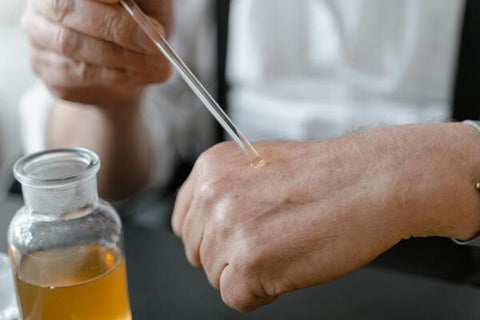Imagine walking into a room and feeling an inexplicable sense of attraction towards you. That's the allure of pheromone perfumes, promising to harness the power of these mysterious chemicals to enhance your magnetism. But are they truly a scientific marvel or simply clever marketing shrouded in a veil of intrigue? Delving into the science of pheromones, their potential influence on human behavior, and the claims of these intriguing fragrances will help us separate fact from fiction.

Pheromone Perfumes – Hype vs. Reality: Unveiling the Scented Truth
The allure of pheromone perfumes is undeniable. They promise to unlock the secrets of attraction, casting an invisible spell of charm and boosting our charisma. But before you rush to buy the latest "pheromone-infused" elixir, let's delve into the reality behind these enticing claims.
Marketing Promises: Pheromone perfumes come wrapped in a veil of seduction, promising enhanced attractiveness, heightened confidence, and an irresistible aura that draws others in. They tap into our primal desires for connection and magnetic allure, making them seemingly irresistible propositions.
The Ingredients: So, what are these mysterious ingredients that supposedly hold the key to unlocking our magnetic potential? The most commonly touted pheromones in these products include:
- Androstenone: Deriving this compound from male sweat, manufacturers claim it enhances women's perception of men's attractiveness and dominance.
- Androstenol: A close relative of androstenone, it's purported to have a calming and mood-lifting effect on both sexes.
- Copulins: These synthetic versions of pheromones found in female vaginal secretions are claimed to attract men and spark arousal.
- Proprietary Blends: Many brands promote their secret formulas as the ultimate attraction weapons, often shrouding the ingredients in a veil of mystery.
Skepticism and Conflicting Evidence: However, the scientific evidence supporting the effectiveness of these perfumes remains limited and often contradicts itself. While some studies hint at potential effects of certain human scents like androstenone, these findings are often inconclusive and riddled with limitations. Additionally, the concentrations of these purported pheromones in perfumes are often negligible, raising questions about their ability to significantly influence human behavior in real-world settings.
Beyond the Pheromone Myth: So, why do some people swear by these products? Here are a few potential explanations:
- The Placebo Effect: The power of belief is potent. Simply believing a product can enhance your attractiveness might lead to a positive self-fulfilling prophecy, boosting confidence and making you appear more approachable.
- Confidence Boost from the Scent: Regardless of pheromones, if the fragrance itself is enjoyable and makes you feel good, it can naturally boost your confidence and improve your posture and non-verbal communication, which can genuinely impact how you come across to others.
- Heightened Awareness of Nonverbal Cues: Feeling more confident and aware due to the scent might lead you to be more receptive to picking up on subtle cues of interest from others, potentially misconstruing them as a result of the "pheromones."
Pheromones – The Basics
Chemical Messengers: Pheromones are fascinating chemical messengers, much like whispers exchanged within a species. These odorless or faint-smelling molecules, secreted by various glands, act as a silent language, conveying information to other individuals of the same species.
Triggering Responses: Imagine a bee encountering a trail of pheromones left by a scout who has discovered a valuable food source. These chemicals act as a signal, prompting the bee to follow the trail and join the feast. Similarly, pheromones play diverse roles in animal behaviour, triggering a range of responses. They can:
- Influence mate selection: Certain pheromones released by potential mates may trigger attraction and influence reproductive choices. For instance, some female moths release sex pheromones that attract males from long distances.
- Signal dominance: In some species, pheromones indicate social hierarchy and dominance. For example, dominant male wolves may release specific scents to signal their position within the pack.
- Trigger physiological changes: Pheromones can even influence physiological processes, such as triggering hormonal changes or altering behaviour patterns. For example, in honeybees, queen pheromones suppress the development of ovaries in worker bees, ensuring the queen's sole reproductive role.
Types of Pheromones: While there are various categories of pheromones, this section focuses primarily on those potentially relevant to human attraction. These include:
- Releaser pheromones: These chemicals cause immediate and temporary behavioral changes in the recipient. For instance, alarm pheromones released by injured insects might trigger a scatter response in their colony.
- Primer pheromones: Unlike releaser pheromones, primers have a slower and longer-lasting effect, influencing development or physiological processes. For example, queen bee pheromones act as primer pheromones, suppressing ovary development in worker bees.
The Search for "Attraction" Pheromones: While the existence of pheromones in animals is well-established, their role in human attraction remains a topic of ongoing research and debate. However, scientists have identified certain human scents that potentially influence behaviour, such as:
- Androstenone: This compound, found in male sweat, may subtly influence women's perceptions of men's attractiveness and dominance.
- Estratetraenol: This pheromone, found in female saliva, might influence men's emotional state and stress levels.

The Science of Human Pheromones
The existence of pheromones in humans sits at the intriguing intersection of science and mystery. While definitive answers remain elusive, ongoing research unveils tantalizing evidence of their potential influence and ignites further exploration.
Intriguing Hints from Studies: Several studies have yielded intriguing findings, suggesting potential roles of human pheromones:
- Menstrual Cycle Synchronization: Studies have shown that women living in close proximity may experience a slight synchronization in their menstrual cycles. This phenomenon, termed the McClintock effect, suggests that exposure to each other's pheromones might play a role. However, further research with larger sample sizes and controlled environments is necessary to solidify these findings.
- Perceptions of Attractiveness: Some studies have investigated the influence of specific human scents on perceived attractiveness. For instance, research suggests that exposure to androstenone, a compound found in male sweat, may subtly affect women's perception of men's attractiveness and dominance. However, it's crucial to remember that these effects are often small and inconsistent, and other factors like individual preferences and hormonal state likely play a significant role.
- Mood Shifts and Arousal: Research exploring the impact of human pheromones on mood and arousal has yielded mixed results. Some studies suggest that exposure to specific scents might influence mood and even sexual arousal. However, these studies often involve controlled laboratory settings, and the real-world implications remain unclear. Additionally, the subjective nature of mood and arousal makes it challenging to draw definitive conclusions.
The Vomeronasal Organ (VNO): A Source of Debate: The VNO, a small organ located in the back of the nasal cavity, plays a crucial role in pheromone detection in some animals. However, its function in humans remains a subject of debate. While humans possess a VNO, its activity and whether it directly relays pheromone signals to the brain are contested. Some studies suggest limited activity, while others propose a potential role in unconscious olfactory processing. Further research is needed to shed light on the VNO's role, if any, in human pheromonal communication.
Complexity Reigns Supreme: Unlike some social insects where pheromones trigger clear and immediate behavioral changes, human pheromonal communication, if it exists, is likely much more nuanced and interwoven with other factors. Here are some complexities to consider:
- Genetic Variations: Our genetic makeup plays a significant role in how we perceive and respond to various stimuli, including potential pheromones. Individual variations in genes related to odor detection can lead to differences in how we perceive specific scents, including potential pheromones.
- The Symphony of Individual Scent: Each individual possesses a unique scent profile, a complex blend of factors like genetics, diet, and lifestyle. This personal "olfactory fingerprint" can influence how others perceive us and potentially interact with the pheromones we might emit.
- Hormonal Dance: The influence of human pheromones, if any, is further intricately woven with the recipient's own hormonal state. For example, a woman's hormonal fluctuations during her menstrual cycle might influence how she responds to potential pheromones.

Debunking Pheromone Perfume Misconceptions
As we navigate the realm of pheromone perfumes, it's crucial to dispel some common misconceptions that can lead to unrealistic expectations:
Myth #1: Irresistible Love Potion: The idea that a few drops of pheromone-infused fragrance can render someone helplessly smitten is a dangerous and misleading narrative. Pheromones, if they have any influence at all in humans, are likely subtle and work in conjunction with other factors. They don't possess magical mind-control powers to manipulate someone's emotions or force them into attraction.
Myth #2: Guaranteed Allure: Pheromones are not a magic potion that guarantees success in the realm of love and attraction. Attraction is a complex tapestry woven from various threads, including physical appearance, shared interests, personality, and even cultural influences. While scent can undoubtedly play a role, it's just one piece of the puzzle. Pheromones alone cannot guarantee a positive outcome, and relying solely on them as a shortcut to attraction can lead to disappointment.
Myth #3: Universal Effect: Even if future research confirms the existence of human pheromones and their role in attraction, it's important to understand that their impact won't be a one-size-fits-all phenomenon. Individual responses are likely to vary significantly based on several factors:
- Genetics: Our genetic makeup plays a role in how we perceive and respond to scents, including potential pheromones. What one person finds attractive might not resonate with another due to individual genetic variations.
- Scent Preference: Beyond the potential influence of pheromones, personal scent preferences play a crucial role. Wearing a fragrance that others find overwhelming or unpleasant is unlikely to be effective, regardless of any purported pheromone content.
- Context and Setting: The environment and context also influence how we perceive and respond to scents. A fragrance that might be considered alluring in an intimate setting could be inappropriate or distracting in a professional setting.
Navigating the World of Pheromone Perfumes
While the scientific evidence supporting the effectiveness of pheromone perfumes remains inconclusive, you might still be curious about exploring them. If you decide to give them a try, here are some recommendations to approach the experience with a balanced perspective:
Finding Your Signature Scent: Remember, the primary function of any fragrance, whether containing pheromones or not, is to create a scent you personally enjoy. Focus on finding a fragrance profile that complements your body chemistry and makes you feel confident and comfortable in your own skin. This self-assuredness is inherently attractive and can significantly impact your interactions with others.
Manage Your Expectations: Approach pheromone perfumes primarily as a fun experiment, not a guaranteed path to romantic success. Remember, attraction is a complex phenomenon influenced by a multitude of factors beyond just scent. While they may offer a hint of intrigue, don't expect them to magically transform your love life.
Choose Reputable Brands: If you do decide to explore pheromone perfumes, opt for brands with a record of transparency. Look for companies that disclose their ingredients (at least to a reasonable extent) and avoid those shrouded in secrecy. This allows you to make informed choices about the products you use and potentially identify any potential allergens.
Safety First: Pheromone perfumes are generally considered safe for most individuals. However, as with any fragrance, it's crucial to be mindful of potential allergic reactions. Test a small amount of the perfume on an inconspicuous area of your skin before applying it liberally. Additionally, consider the context and setting when wearing these fragrances. Strong scents might be overwhelming or inappropriate in certain environments like professional settings or crowded spaces.
Remember the Bigger Picture: While the allure of pheromone perfumes is undeniable, it's essential to remember that genuine connection and lasting attraction are built on a deeper foundation. Invest in fostering personal qualities like kindness, confidence, and a genuine interest in others. These attributes, along with authentic self-expression, are far more powerful in attracting others than any fragrance, with or without purported pheromones.
Conclusion
As we conclude our exploration of pheromones and their potential role in human attraction, a captivating yet enigmatic landscape unfolds before us. While the existence of pheromones in humans is confirmed, their intricate workings and influence on our behavior remain a scientific mystery, filled with unanswered questions and ongoing research. This very lack of definitive answers fuels the continued allure of pheromone perfumes. They offer a glimpse into the enigmatic world of chemical communication, sparking our curiosity and tapping into our primal desires for connection and attraction.
However, it's crucial to approach these products with a balanced perspective. We must acknowledge the limitations of current research and the complex tapestry of factors that contribute to genuine attraction, far exceeding the realm of just scent. While pheromones might hold a hint of intrigue, their effectiveness in influencing human behavior remains largely unproven.
Ultimately, whether or not pheromone perfumes hold any real power in unlocking irresistible allure might be a matter of personal experience. Some might find the potential for a subtle confidence boost or a hint of intrigue outweighs the lack of conclusive scientific evidence. However, it's vital to remember that true connection thrives on more than just fleeting scents. Investing in fostering personal qualities like kindness, confidence, and genuine interest in others holds far greater power. When you cultivate these qualities, you attract individuals who appreciate you for who you truly are, beyond the superficial allure of any fragrance.
Therefore, embrace your individuality and let your unique personality shine through. While a hint of mystery can be undeniably seductive, the power of genuine connection lies in authenticity, shared values, and a mutual desire to build meaningful relationships. Remember, the most captivating fragrance you can wear is the essence of your true self. It's the unique blend of your personality, your kindness, and your genuine interest in others that truly attracts those who appreciate you for who you are.
This journey of exploring pheromones and attraction reminds us that the essence of connection lies not in fleeting scents or quick fixes, but in the timeless power of authenticity and genuine human interaction. Embrace the mystery, nurture your individuality, and let your true self be the most captivating fragrance you wear.



